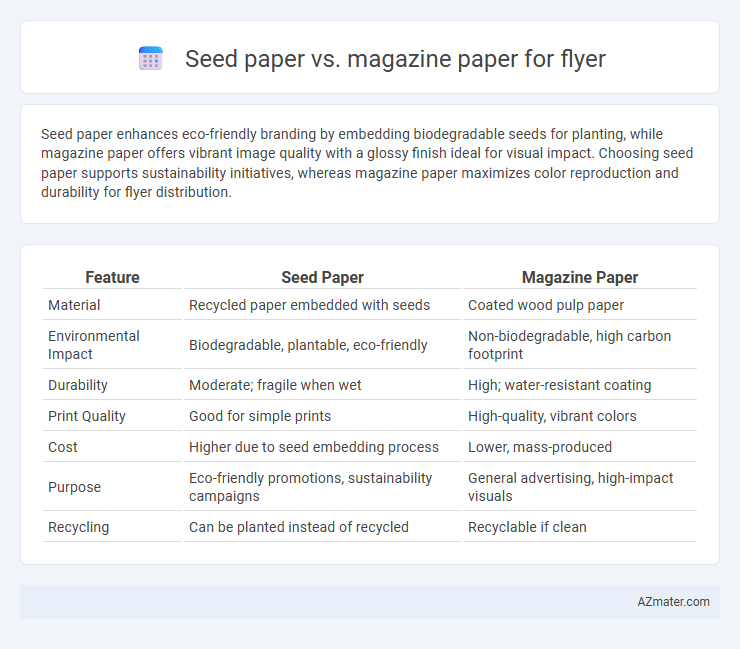Seed paper enhances eco-friendly branding by embedding biodegradable seeds for planting, while magazine paper offers vibrant image quality with a glossy finish ideal for visual impact. Choosing seed paper supports sustainability initiatives, whereas magazine paper maximizes color reproduction and durability for flyer distribution.
Table of Comparison
| Feature | Seed Paper | Magazine Paper |
|---|---|---|
| Material | Recycled paper embedded with seeds | Coated wood pulp paper |
| Environmental Impact | Biodegradable, plantable, eco-friendly | Non-biodegradable, high carbon footprint |
| Durability | Moderate; fragile when wet | High; water-resistant coating |
| Print Quality | Good for simple prints | High-quality, vibrant colors |
| Cost | Higher due to seed embedding process | Lower, mass-produced |
| Purpose | Eco-friendly promotions, sustainability campaigns | General advertising, high-impact visuals |
| Recycling | Can be planted instead of recycled | Recyclable if clean |
Introduction: Understanding Seed Paper and Magazine Paper
Seed paper is an eco-friendly material embedded with seeds that can be planted after use, promoting sustainability and reducing waste. Magazine paper, typically coated and glossy, offers vibrant color reproduction and smooth texture ideal for eye-catching flyers but has limited recyclability. Choosing between seed paper and magazine paper depends on balancing environmental impact with print quality and budget considerations.
Environmental Impact: Eco-Friendliness Compared
Seed paper significantly reduces environmental impact by being composed of biodegradable materials embedded with seeds, allowing flyers to be planted and transformed into vegetation rather than discarded as waste. Magazine paper, typically made from coated, bleached pulp with chemical additives, often involves energy-intensive production and contributes to landfill accumulation due to limited recyclability. Choosing seed paper for flyers promotes sustainability through natural decomposition and plant growth, contrasting with the higher carbon footprint and pollution associated with conventional magazine paper.
Production Process: How Each Paper Type is Made
Seed paper is handcrafted by embedding seeds within biodegradable pulp made mostly from recycled paper, ensuring an eco-friendly production that supports plant growth after use. Magazine paper is typically manufactured through a large-scale, industrial process involving wood pulp combined with various chemical coatings to achieve glossy, smooth finishes ideal for vibrant printing. The seed paper production emphasizes sustainability and minimal chemical usage, whereas magazine paper focuses on high-quality image reproduction and mass production efficiency.
Print Quality: Visual Appeal and Color Vibrancy
Seed paper offers a unique textured surface that enhances visual appeal with a natural, eco-friendly aesthetic but may result in slightly muted color vibrancy compared to traditional papers. Magazine paper, designed for high-quality color reproduction, delivers sharp images and vivid, consistent hues, making it ideal for vibrant flyers requiring precise detail. For print quality, magazine paper excels in color clarity and brightness, while seed paper provides an organic look that complements earthy and sustainable branding.
Biodegradability and Sustainability
Seed paper outperforms magazine paper in biodegradability due to its embedded seeds that naturally decompose and promote plant growth, enhancing environmental sustainability. Magazine paper, often coated with inks and chemicals, resists rapid breakdown and contributes to landfill waste. Choosing seed paper for flyers significantly reduces ecological impact and supports circular economy principles in sustainable marketing.
Cost Analysis: Affordability for Flyer Printing
Seed paper typically costs 20-40% more than standard magazine paper due to its eco-friendly materials and biodegradable properties, impacting the overall flyer printing budget. Magazine paper offers a lower cost per unit with smoother finish options, making it a budget-friendly choice for large quantities. Balancing cost with environmental impact is crucial when deciding between seed paper's sustainability benefits and magazine paper's affordability for flyer production.
Customization Options for Flyers
Seed paper offers unique customization options such as embedding wildflower seeds directly into the paper, creating eco-friendly and interactive flyers that encourage planting and sustainability. Magazine paper provides high-resolution printing with vibrant colors and a smooth finish, allowing detailed graphics and professional designs ideal for visually striking marketing materials. Choosing between seed paper and magazine paper depends on whether the flyer's focus is on environmental impact and novelty or on high-quality, glossy presentation.
Distribution and Handling Differences
Seed paper flyers offer eco-friendly benefits by being biodegradable and plantable, ideal for environmentally conscious campaigns; they require gentle handling to avoid premature damage, making them best suited for direct handouts or limited distribution. Magazine paper is glossy, durable, and designed for mass distribution through mail or bulk drops, providing vibrant color reproduction and resistance to wear but lacking environmental benefits. The choice between seed paper and magazine paper depends on balancing sustainable goals with the desired reach and handling requirements of the flyer campaign.
Best Use Cases: When to Choose Seed Paper or Magazine Paper
Seed paper is ideal for eco-friendly promotions, event invitations, and sustainability-focused campaigns where recipients can plant the flyer to grow flowers or herbs. Magazine paper suits vibrant, high-quality print materials that require sharp images and glossy finishes, perfect for product launches, fashion promotions, and detailed informational flyers. Choosing seed paper enhances brand values tied to environmental responsibility, while magazine paper maximizes visual impact and professional appeal.
Conclusion: Making the Right Choice for Your Flyer
Choosing between seed paper and magazine paper for your flyer depends on your marketing goals and environmental values. Seed paper offers an eco-friendly option that encourages brand engagement through plantable material, ideal for sustainability-focused campaigns. Magazine paper provides vibrant, high-quality print results suitable for broad distribution and visually impactful promotions.

Infographic: Seed paper vs Magazine paper for Flyer
 azmater.com
azmater.com